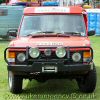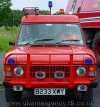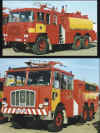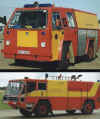Category: Airport Fire
PX55 OSF This tri-axle Land Rover conversion is a fast response …

PX55 OSF This tri-axle Land Rover conversion is a fast response fire engine for airfield use. It is a demonstrator from Yorkshire-based Angloco. The most prominent feature is the roof-mounted foam / water cannon. This can begin to quell flames or cover a fuel leak with foam as the vehicle arrives on the scene.
The rear view of the Land Rover. It is fitted with blue lights (to the front only), white lights down the sides to illuminate the scene and an amber light for airfield driving. The roof-mounted ladders can be seen as well as a telescopic floodlight.
Here we have a large, yellow 8 wheeled airfield crash …

Here we have a large, yellow 8 wheeled airfield crash tender. It has registration ’96 L 6′ and is an Emergency-One/Teledyne/Continental Motors Aircraft Rescue Fire Fighting P-23 from the United States Air Force (Europe) demonstrating “Jet Throw” at Royal Air Force Fairford. It is fairly unusual to see this colour scheme used by USAF Crash Vehicles outside of the United States.
JOR 359P This Land Rover is a hybrid of series II, series …

JOR 359P This Land Rover is a hybrid of series II, series III and military parts. It is used as an emergency response unit at Rufforth airfield, North Yorkshire.
The rear view, showing the relatively small array of fire fighting equipment carried. This vehicle is used because the Civil Aviation Authority requires there to be some form of fire cover at airfields.
F743 MDN This Range Rover is an ex-RAF fire fighting vehicle …

F743 MDN This Range Rover is an ex-RAF fire fighting vehicle owned by Hields Aviation. It is used as ground support for the Yorkshire Air Ambulance as well as private purposes. On this frontal view, notice the large winch which means that the registration plate has had to be moved to the bonnet.
The front/side view shows that this vehicle has three axels. It can be switched between four-wheel drive and six-wheel drive. On smooth high speed roads it wallows around and is more at home off-road.
The rear view showing the locker, roof-mounted ladders and spotlight.
KAY 39V is an open-top yellow Landrover 88 which is used …

KAY 39V is an open-top yellow Landrover 88 which is used for fire and emergency rescue cover at Breighton Airfield, North Yorkshire. Notice the upturned ‘Hello!’ on the front of the nearside wing. It is designed so that it can be read by a pilot in a upturned crashed plane as the rescue vehicle approaches!
The rear view of the Landrover showing the fire extinguishers and other equipment carried in the back. The vehicle is owned and run by The Real Aeroplane Company Ltd.
WNE 371L This is a Reynolds Broughton Chubb ‘Pathfinder’ airfield …

WNE 371L This is a Reynolds Broughton Chubb ‘Pathfinder’ airfield fire appliance seen at the Yorkshire Air Museum, at Elvington near York. Although a museum, the airfield occasionally receives some flights. The appliance is mainly there to protect the exhibits.
It was initially used by Manchester International Airport Fire service. It is built on a ‘Griffin’ 6-wheel drive high performance chassis at has a top speed of about 60 mph. This vehicle is immense. It measures 37’4″ (12.9m) long, 10′ (3.4m) wide and 13’7″ (5.0m) high.
This vehicle is design for a crew of four, but can be operated by only one person. This model dates back to 1972. The pathfinder was awarded the Design Council’s Engineering award in 1974 in respect of its then advanced design.
B233 XMY Also to be found at Elvington is this 1984 Range …

B233 XMY Also to be found at Elvington is this 1984 Range Rover rapid intervention vehicle. It is ultimately quicker than the Pathfinder, but can only carry a limited amount of supplies.
It is different to a normal range rover by having an additional set of driven wheels, making it 6-wheel drive. It is powered by a Rover V8 engine, and had a separate water pump.
























